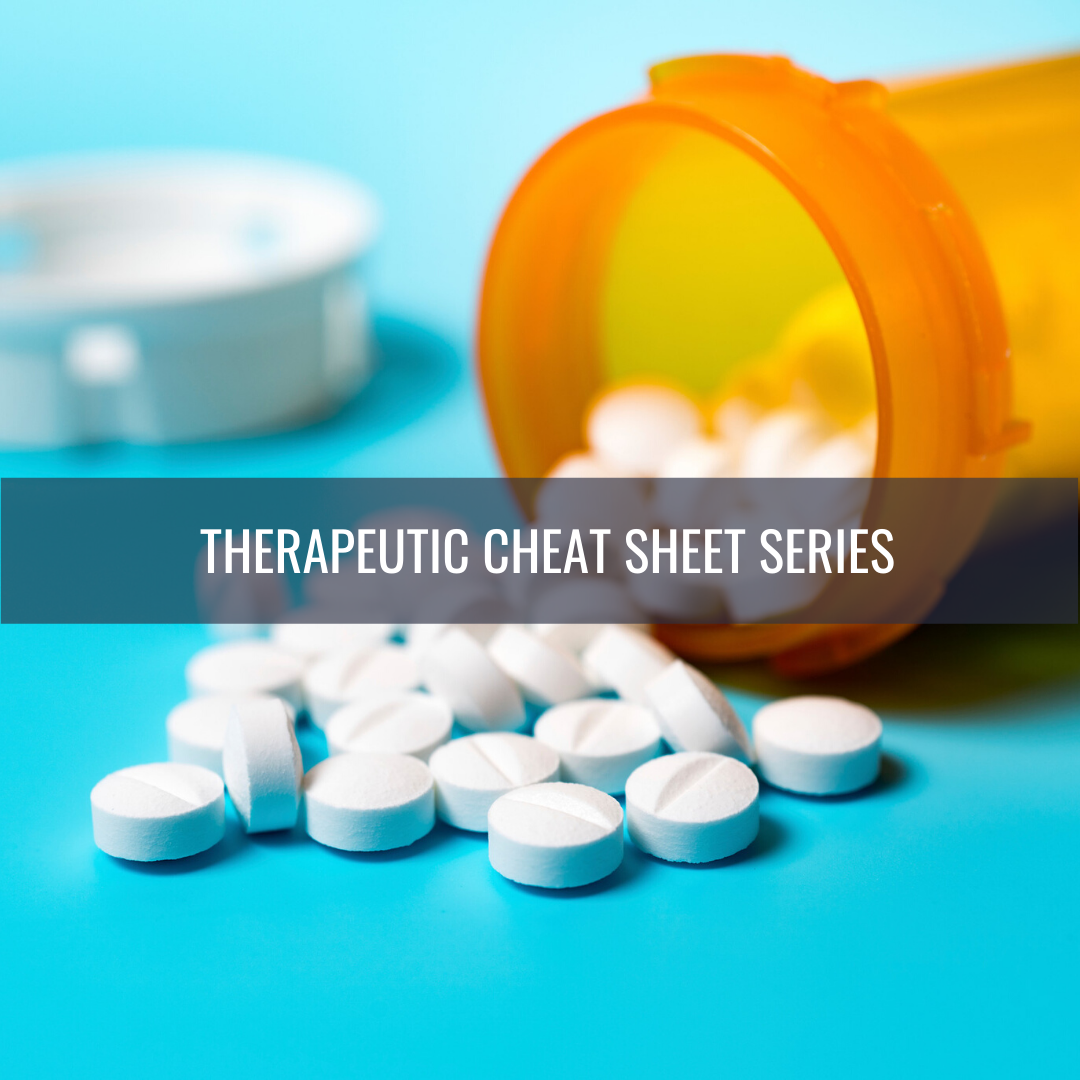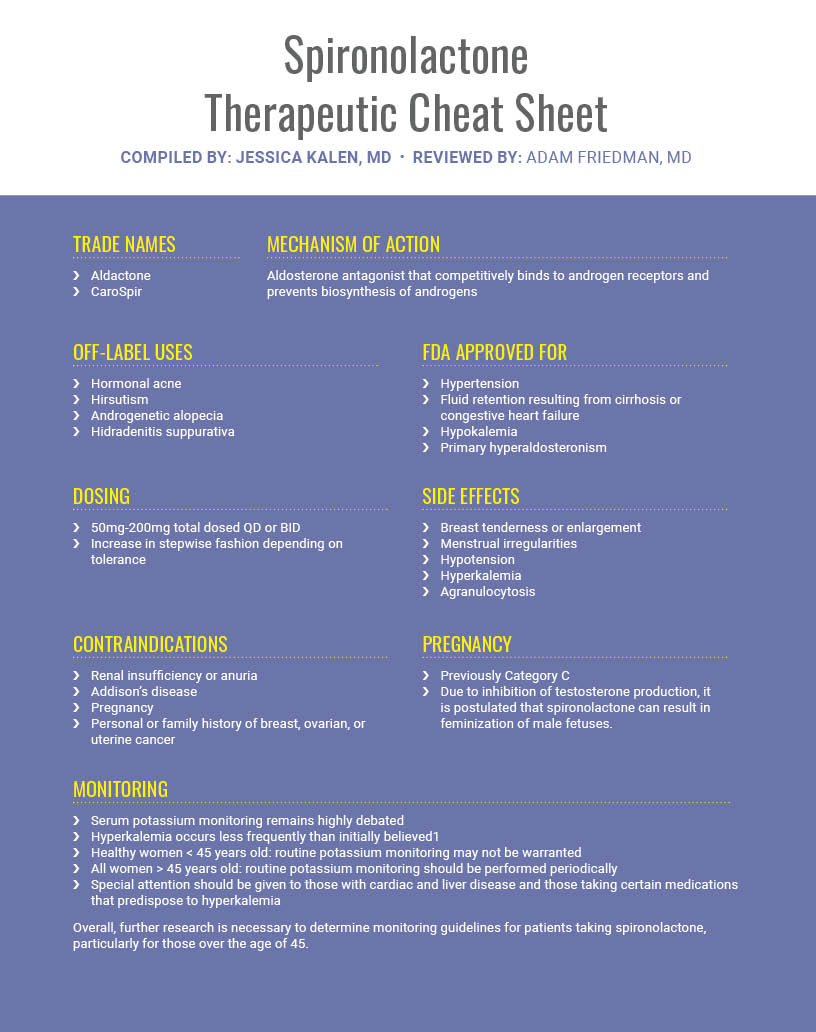Hormonal acne is a prevalent and frustrating condition among many women. For those who are unable to control the disease with topical medications alone, spironolactone is often a useful systemic agent. However, its off-label use and potential risk of hyperkalemia have raised the question about serum potassium monitoring. We continue our Therapeutic Cheat Sheet series, with a closer look at spironolactone. Have COVID-19 questions? Check out the news/resource center.
Further Reading
If you would like to read more about spironolactone, check out the following 2 articles published in the Journals of Drugs in Dermatology:
John S. Barbieri MD MBA, Juliana K Choi MD PhD, Nandita Mitra PhD, David J Margolis MD PhD
BACKGROUND: Long-term oral antibiotic use in acne may be associated with a variety of adverse effects including antibiotic resistance, pharyngitis, inflammatory bowel disease, and breast and colon cancer. Spironolactone may represent an effective and safe alternative to oral antibiotics for women with moderate to severe acne, however, comparative studies are lacking.
METHODS: Using the OptumInsight™ Clinformatics™ DataMart, we conducted a retrospective analysis of the frequency of switching to a different systemic agent within the first year of therapy among women with acne who were started on either spironolactone or an oral tetracycline-class antibiotic between 2010-2016, after controlling for age, topical retinoid, and oral contraceptive use.
RESULTS: Among women with acne who were started on spironolactone, 14.4% were prescribed a different systemic agent within one year, compared with 13.4% started on an oral tetracycline-class antibiotic. After adjusting for age, topical retinoid, and oral contraceptive use, the odds ratio for being prescribed a different systemic agent within one year was 1.07 (95% CI 0.99-1.16) for those prescribed spironolactone when compared with oral tetracycline-class antibiotics and the risk difference was 0.007 (95% CI -0.002-0.017).
CONCLUSIONS: Based on the observation of similar switching between the two groups, spironolactone may have similar clinical effectiveness to that of oral tetracycline-class antibiotics. While ultimately large clinical trials are needed to determine the optimal management strategy for women with moderate to severe acne, these results provide additional support that spironolactone represents an effective treatment for women with acne.
Spironolactone and Topical Retinoids in Adult Female Cyclical Acne.
Erin Lessner MD, Samantha Fisher MD, Katherina Kobraei MD, Michael Osleber MD, Rebecca Lessner BS, Lauren Elliott MD, and Stanton Wesson MD.
PURPOSE: To access the efficacy of spironolactone and topical retinoids in the treatment of female cyclical acne.
METHODS: A retrospective chart review on 41 female patients age 19-57 years old with cyclical acne was performed. Patients were examined over the course of 2 to 102 months while taking 50 to 200 mg of spironolactone and topical tretinoin 0.025% or adapalene 0.1% cream. All were diagnosed with acne rated mild to severe, prior to treatment, and were started on an initial dose of 50 mg po daily. If significant improvement was not seen within the first 3-6 months, the dose was either held or increased in 25 mg increments every 3 months. Patients on oral and topical antibiotics, as well as patients on photodynamic therapy were excluded from the study. The response to treatment was rated on a 0-4 scale with 0 being no response and 4 corresponding to clear skin.
RESULTS: One patient (2.4%) had no response to treatment. This patient was only on 50 mg po daily for only 2 months. Only 5 (12.2%) patients had minimal response to treatment and 9 (22.0%), 12 (29.3%), and 14 (34.1%) had a good, excellent, or clear response respectively. The study showed 26 (63.4%) women on treatment with spironolactone and topical retinoids had an excellent or clear outcome, and 35 (85.4%) were considered to have a good, excellent, or clear response.
CONCLUSION: The addition of spironolactone to topical retinoid treatment suggests a superior response to retinoids alone in clearance of female adult cyclical acne.
References
- Plovanich M, Weng QY, Mostaghimi A. Low usefulness of potassium monitoring among healthy young women taking spironolactone for acne. JAMA Dermatol. 2015;151(9):941-944.
- Thiede RM, et al. Hyperkalemia in women with acne exposed to oral spironolactone: a retrospective study from the RADA (Research of Adverse Drug Events and Reports) program. Int J Womens Dermatol. July 2019;5(3):155-157.
Did you enjoy this therapeutic cheat sheet? You can find more here.


